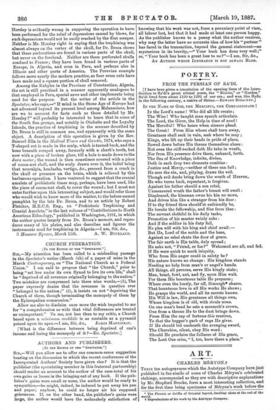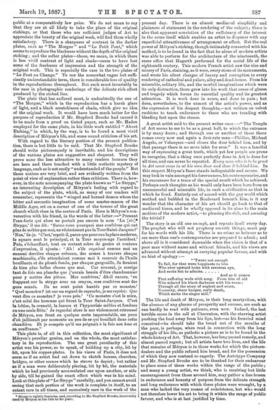ART.
THESE ten autogravures which the Autotype Company have jug published in fac-simile of some of Charles M6ryon's celebrated etchings, accompanied as they are with descriptive explanations by Mr. Stopford Brooke, form a most interesting collection, and for the first time bring specimens of Mdryon's work before the
• The Pawl: or Griffin of Oriental legend, dwelling alone at the end of tho World. t ReProdnotione of hie work by the Autotype Company.
public at a comparatively low price. We do not mean to say that they are at all likely to take the place of the original etchings, or that those who are sufficient judges of Art to appreciate the beauty of the original work, will find them wholly satisfactory. There is a sharpness of contrast in the darker plates, such as "The Morgue" and "Le Petit Pont," which seems to reproduce the blackness without the depth of the original etching; and the softer plates—those, we mean, in which there is less vivid contrast of light and shade—seem to have lost some of the freshness of impression and the strength of the original work. This is especially the case in the two plates of "Le Pont an Change." To use the somewhat vague but suffi- ciently understandable term, there is considerable loss of quality in the reproductions throughout. But such must invariably be the case in photographic renderings of the delicate rich effect produced by the etched line.
The plate that has suffered most, is undoubtedly the one of "The Morgue," which in the reproduction has a harsh glare of light, and a black scratchiness of shade, which give no idea of the original work. It would have been much better for the purpose of reproduction if Mr. Stopford Brooke had caused it to be made from a proof on tinted paper, such as Mr. Haden employed for the same plate, in his little work entitled "About Etching," in which, by the way, is to be found a most vivid description of MEryou's life, and some sound criticism of his art. With regard to the literary portion of the present publica- tion, there is but little to be said. That Mr. Stopford Brooke should write picturesquely is inevitable, and his descriptions of the various plates are suggestive and eloquent. They will prove none the less attractive to many readers because they are here and there touched with a little ;Pathetic mystery of language, such as is not easily " understanded of the people." Bat these notices are very brief, and are evidently written from the point of view of explanation rather than criticism. There is, how- over, in the note accompanying the plate known as "Le Stryge," an interesting description of M6ryon's feeling with regard to the subject of the plate, which, as many of our readers will remember, represents the "winged and horned demon whom the bitter and sarcastic imagination of some master-mason of the Middle Ages, set on a corner of one of the towers of the great church which rises in the centre of Paris. Here is Meryou's con- versation with his friend, in the words of the latter :—" Prenant rean-forte qui alms ne portait pas encore is nom `La [sic]* Stryge,' il me dit • Savez-vous pourquoi mes confreres qui ont plus de metier que moi, ne r6aississent pas la Tour Saint-Jacques?'
'Non,' fis-je. parce pie pour eux la place moderns, de square sont le principal, et is Tour moyen-age raccident.' Pais, s'echanffant, tout en restant sobre de gestes et content;
-d'expression, il ajouta : ! s'ils voyaient comma moi on onnemi derriere cheque cronean, des armes k travers cheque machicoulis, s'ils attendaient comma moi h recevoir de l'huile bouillante et do plumb fondu, par cheque gargouille, ils feraient de hien plus belles choses que moi. Car sonvent, je corrige tent de fois ma planate que j'aurais beeoin d'atre chandronnier pour y mettre des pieces. Ides confreres,' cliteil encore, en frappant sur in stryge avec on crayon, mes confreres sont des gene sensSs. ne no sont point hantes par ce monstre.' Quel monstre P (et sur nn regard de reproche, je me repris) : Que vent dire ce monstre P je vous prie." Ce monstre c'e.st le mien, c'est add des hommes qui firent la Tour Saint-Jacques. C'est la b6tise, la ernante, In luxure et rhypocrisie shies et fondues .ennnesenleBhte.'Jo regardai elm Is nez violemment retrousse M6ryon, son front en quelque sorts impernAable, see your d'ofi jailliseait par moments on pen de cc qui laouillait dans cette ohandiere. Et je compris qu'il me peignait Is In fois son ame et 813, souffrance."
This plate is, of all in this collection, the most significant of Meryon's peculiar genius, and on the whole, the most satisfac- tory in its reproduction. The one great peculiarity of this artist was his power, so to speak, of building up a city, bit by bit, upon his copper-plates. In his views of Paris, it does not seem as if an artist had sat down to sketch housee, churches, bridges, or other scenes which he strove to depict ; but rather se if a man were deliberately placing, bit by bit, the materials which he had previously accumulated one upon another, or side by side, till he gained the exact effect which was in his mind. Look at this plate of "Le Stryge" carefully, and you cannot avoid seeing that each portion of the work is complete in itself, to an -extent rare in all times, and excessively rare in the work of the
• tfivi:rightly nitn end, to Mr. Brooks, iy67(taittlii
present day. There is an almost mediaaval simplicity and plainness of statement in the rendering of the subject ; there is also that apparent conviction of the sufficiency of the interest in the scene itself which enables an artist to dispense with any superficial attractiveness of arrangement or effect. But the real power of Miiryon's etching, though intimately connected with his method, is to be found in the fact that he alone of modern artists was able to perform for the architecture of the nineteenth, the same office that Hogarth performed for the social life of the eighteenth century. This modern French artist saw the vice and misery of Paris, staining, as it were, every stone of its monuments, and wrote his silent charges of luxury and corruption in every rendering of cathedral and palace, alley and dead-house. From his miserable, solitary life, and the morbid imaginations which were its only distraction, there grew into his work that sense of gloom and tragedy which forms its essential quality and its greatest attraction. It is work done in scorn, and done in pain ; but done, nevertheless, to the utmost of the artist's power, and as the expression of his deepest thoughts,—not written on velvet cushions to teach endurance to those who are treading with bleeding feet upon the stones.
A great artist said to the present writer once :—" The Temple of Art seems to me to be as a great hall, to which the entrance is by many doors ; and through one or another of these there comes every now and again a firat-rate man—Phidias, Michael Angelo, or Velasquez —and closes the door behind him, and by that passage there is no more inlet for ever." It was a fanciful way of expressing a great truth, which yet few people are prone to recognise, that a thing once perfectly done in Art is done for all time, and can never be repeated. Every man who is to be great in Art must come in at his own door and dose it behind him. In this respect M6ryon's fame stands indisputable and secure. We may look in vain amongst his forerunners, his contemporaries, and his successors for a trace of the special result which he achieved. Perhaps such thoughts as his would only have been born from an unsuccessful and miserable life, in such a civilisation as that in which he lived. Entirely out of accord, with the gay world which seethed and babbled in the Boulevard beneath him, is it any wonder that the character of his art should go back to that of medimval times, and be wholly opposed in its aims to the main motives of the modern artist,—to pleasing the rich, and amusing the trivial ?
The story is an old one enough, and repeats itself every day. The prophet who will not prophesy smooth things, must pay for his words with his life. There is no crime so heinous as to see more than one's contemporaries are prepared to admit ; and above all is it considered damnable when the vision is that of a poor man without name and without friends, and his views are advanced without attempt at currying popular favour, and with no hint of apology :—
"'Torero not enough To fail, for that were happiness to him Who over upward looks with reverent eye, And seeks but to admire And so it comes That suffering weds with song. From him of old Who solaced his blank darkness with his verse; Through all the story of neglect and scorn, Necessity, sheer hunger, early death, Which smite the singer still.'
The life and death of M‘ryon, in their long martyrdom, with the absence of any gleams of prosperity and success, are such as can hardly be read with patience, even now. Indeed, the last terrible scene in the cell at Charenton, with the starving artist pushing the food away from his lips, lest—as his frenzied mind conceived—he should take the bread out of the mouths of the poor, is perhaps, when read in connection with the long struggle of his life, as pathetic a picture as is to be found in the whole history of Art. That, however, has long passed remedy, and almost passed regret ; but all artists have two lives, and the life that remains of Mdryon is in those works for which the picture- dealers and the public refused him bread, and for the possession of which they now contend so eagerly. The Autotype Company and Mr. Stopford Brooke are to be thanked for their endeavour to place some of these works within the range of the public ; and many a young artist, we think, who is receiving but little encouragement from those around him, may gather a fine lesson in endurance and honesty of purpose from the delicate strength and long endurance with which these plates were wrought, by a man who lacked the very means of subsistence, but who would not therefore lower his art to bring it within the range of public; favour, and who is at last justified by time.



































 Previous page
Previous page